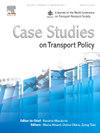Coverage evaluation of public electric vehicle charging stations in Bangkok, Thailand using location-allocation model
IF 2.4
Q3 TRANSPORTATION
引用次数: 0
Abstract
Electric vehicles (EVs) have emerged as a promising solution to address environmental concerns. With the global rise in EV adoption, establishing an efficient and accessible charging infrastructure is crucial. Charging stations play a vital role in facilitating EV adoption by providing convenient locations for vehicle recharging. However, research assessing the effectiveness of charging stations in meeting EV users’ demands and ensuring their coverage in Thailand is limited. This study evaluates the distribution of public charging stations in Bangkok, Thailand, by analyzing spatial accessibility and considering access limitations and service capabilities. Location-allocation analysis in ArcGIS Pro is employed to assesses the coverage of existing charging stations relative to estimated charging demands. Questionnaire survey results, including EV model and charging behavior information, are used to determine capacity constraints of each charging station. The sensitivity analysis was also performed to highlight the impact of operating hours and SoC regain levels on demand coverage and station selection. Findings reveal that existing public charging stations generally meet the charging demand, but capacity and distribution need attention. Additional charging stations are necessary in specific sub-districts to effectively meet the growing demand, and coverage decreases when considering peak hour constraints, emphasizing the need for strategic expansion. The sensitivity analysis results imply that flexible service strategies and demand-responsive planning are essential to optimize the efficiency and accessibility of charging infrastructure.
基于位置-分配模型的泰国曼谷公共电动汽车充电站覆盖评价
电动汽车(ev)已经成为解决环境问题的一个有希望的解决方案。随着全球电动汽车的普及,建立一个高效、便捷的充电基础设施至关重要。充电站通过提供方便的车辆充电地点,在促进电动汽车普及方面发挥着至关重要的作用。然而,评估充电站在满足电动汽车用户需求和确保其覆盖范围方面的有效性的研究在泰国有限。本研究通过分析曼谷公共充电站的空间可达性,并考虑充电站的接入限制和服务能力,对泰国曼谷公共充电站的分布进行了评价。利用ArcGIS Pro中的位置分配分析,相对于估计的充电需求,评估现有充电站的覆盖范围。利用问卷调查结果,包括电动汽车模型和充电行为信息,确定各充电站的容量约束条件。还进行了敏感性分析,以突出运行时间和SoC恢复水平对需求覆盖率和站点选择的影响。研究结果表明,现有的公共充电站基本能满足充电需求,但容量和分布需要注意。为了有效满足不断增长的需求,需要在特定街道增加充电站,考虑到高峰时段的限制,覆盖范围会下降,强调需要进行战略扩张。敏感性分析结果表明,灵活的服务策略和需求响应规划是优化充电基础设施效率和可及性的必要条件。
本文章由计算机程序翻译,如有差异,请以英文原文为准。
求助全文
约1分钟内获得全文
求助全文

 求助内容:
求助内容: 应助结果提醒方式:
应助结果提醒方式:


